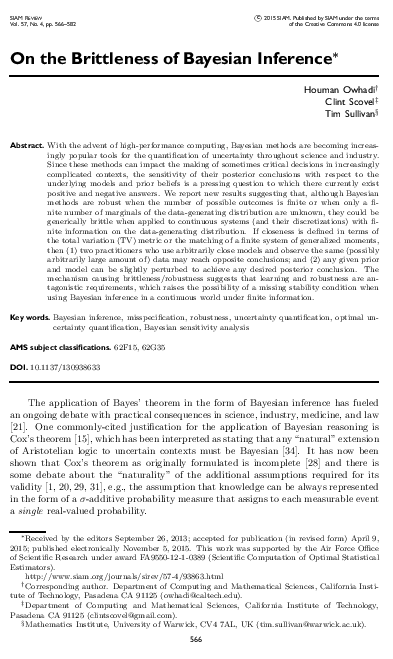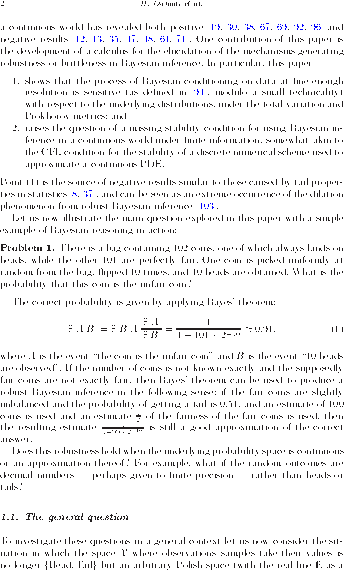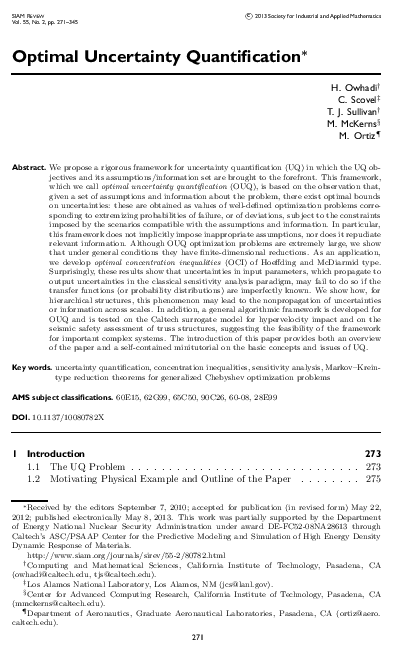#scovel

Bayesian Brittleness in SIAM Review
The 2015 Q4 issue of SIAM Review will carry an article by Houman Owhadi, Clint Scovel, and myself on the brittle dependency of Bayesian posteriors as a function of the prior. This is an abbreviated presentation of results given in full earlier this year in Elec. J. Stat. The PDF is available for free under the terms of the Creative Commons 4.0 licence.
H. Owhadi, C. Scovel, and T. J. Sullivan. “On the brittleness of Bayesian inference.” SIAM Review 57(4):566–582, 2015.
Abstract. With the advent of high-performance computing, Bayesian methods are becoming increasingly popular tools for the quantification of uncertainty throughout science and industry. Since these methods can impact the making of sometimes critical decisions in increasingly complicated contexts, the sensitivity of their posterior conclusions with respect to the underlying models and prior beliefs is a pressing question to which there currently exist positive and negative answers. We report new results suggesting that, although Bayesian methods are robust when the number of possible outcomes is finite or when only a finite number of marginals of the data-generating distribution are unknown, they could be generically brittle when applied to continuous systems (and their discretizations) with finite information on the data-generating distribution. If closeness is defined in terms of the total variation (TV) metric or the matching of a finite system of generalized moments, then (1) two practitioners who use arbitrarily close models and observe the same (possibly arbitrarily large amount of) data may reach opposite conclusions; and (2) any given prior and model can be slightly perturbed to achieve any desired posterior conclusion. The mechanism causing brittleness/robustness suggests that learning and robustness are antagonistic requirements, which raises the possibility of a missing stability condition when using Bayesian inference in a continuous world under finite information.
Published on Friday 6 November 2015 at 12:00 UTC #publication #siam-review #ouq #bayesian #owhadi #scovel

Bayesian Brittleness in Elec. J. Stat.
The Electronic Journal of Statistics has published an article by Houman Owhadi, Clint Scovel, and myself on the brittle dependency of Bayesian posteriors as a function of the prior.
H. Owhadi, C. Scovel, and T. J. Sullivan. “Brittleness of Bayesian inference under finite information in a continuous world.” Electronic Journal of Statistics 9(1):1–79, 2015.
Abstract. We derive, in the classical framework of Bayesian sensitivity analysis, optimal lower and upper bounds on posterior values obtained from Bayesian models that exactly capture an arbitrarily large number of finite-dimensional marginals of the data-generating distribution and/or that are as close as desired to the data-generating distribution in the Prokhorov or total variation metrics; these bounds show that such models may still make the largest possible prediction error after conditioning on an arbitrarily large number of sample data measured at finite precision. These results are obtained through the development of a reduction calculus for optimization problems over measures on spaces of measures. We use this calculus to investigate the mechanisms that generate brittleness/robustness and, in particular, we observe that learning and robustness are antagonistic properties. It is now well understood that the numerical resolution of PDEs requires the satisfaction of specific stability conditions. Is there a missing stability condition for using Bayesian inference in a continuous world under finite information?
Published on Tuesday 3 February 2015 at 10:00 UTC #publication #elec-j-stat #ouq #bayesian #owhadi #scovel

Optimal Uncertainty Quantification in SIAM Review
The 2013 Q2 issue of SIAM Review will carry an article by Houman Owhadi, Clint Scovel, Mike McKerns, Michael Ortiz, and myself on the optimization approach to uncertainty quantification in the presence of infinite-dimensional epistemic uncertainties about the probability measures and response functions of interest.
We present both a mathematical framework for the reduction of such infinite-dimensional problems to finite-dimensional effective feasible sets, and apply the methods to practical examples arising in hypervelocity impact and seismic safety certification.
H. Owhadi, C. Scovel, T. J. Sullivan, M. McKerns, and M. Ortiz. “Optimal Uncertainty Quantification.” SIAM Review 55(2):271–345, 2013.
Abstract. We propose a rigorous framework for uncertainty quantification (UQ) in which the UQ objectives and its assumptions/information set are brought to the forefront. This framework, which we call optimal uncertainty quantification (OUQ), is based on the observation that, given a set of assumptions and information about the problem, there exist optimal bounds on uncertainties: these are obtained as values of well-defined optimization problems corresponding to extremizing probabilities of failure, or of deviations, subject to the constraints imposed by the scenarios compatible with the assumptions and information. In particular, this framework does not implicitly impose inappropriate assumptions, nor does it repudiate relevant information. Although OUQ optimization problems are extremely large, we show that under general conditions they have finite-dimensional reductions. As an application, we develop optimal concentration inequalities (OCI) of Hoeffding and McDiarmid type. Surprisingly, these results show that uncertainties in input parameters, which propagate to output uncertainties in the classical sensitivity analysis paradigm, may fail to do so if the transfer functions (or probability distributions) are imperfectly known. We show how, for hierarchical structures, this phenomenon may lead to the nonpropagation of uncertainties or information across scales. In addition, a general algorithmic framework is developed for OUQ and is tested on the Caltech surrogate model for hypervelocity impact and on the seismic safety assessment of truss structures, suggesting the feasibility of the framework for important complex systems. The introduction of this paper provides both an overview of the paper and a self-contained minitutorial on the basic concepts and issues of UQ.
Published on Monday 10 June 2013 at 20:00 UTC #publication #siam-review #ouq #owhadi #scovel #mckerns #ortiz